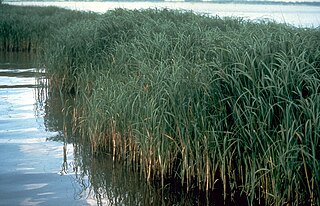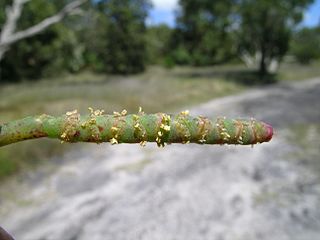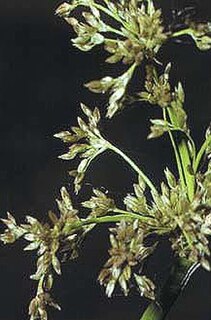
A halophyte is a salt-tolerant plant that grows in soil or waters of high salinity, coming into contact with saline water through its roots or by salt spray, such as in saline semi-deserts, mangrove swamps, marshes and sloughs and seashores. The word derives from Ancient Greek ἅλας (halas) 'salt' and φυτόν (phyton) 'plant'. Halophytes have different anatomy, physiology and biochemistry than glycophytes. An example of a halophyte is the salt marsh grass Spartina alterniflora. Relatively few plant species are halophytes—perhaps only 2% of all plant species. Information about many of the earth's halophytes can be found in the ehaloph database.

The Eastern Desert is the part of the Sahara desert that is located east of the Nile river. It spans 223,000 square kilometres (86,000 sq mi) of North-Eastern Africa and is bordered by the Nile river to the west and the Red Sea and Gulf of Suez to the east. It extends through Egypt, Eritrea, Sudan and Ethiopia. The Eastern Desert is also known as the Red Sea Hills. The Desert consists of a mountain range which runs parallel to the coast, wide sedimentary plateaus extending from either side of the mountains and the Red Sea coast. The rainfall, climate, vegetation and animal life sustained in the desert varies between these different regions.The Desert has been a mining site for building materials, and precious and semi-precious metals throughout history. It has historically contained many trade routes leading to and from the Red Sea, including the Suez Canal.

Salsola soda, more commonly known in English as opposite-leaved saltwort, oppositeleaf Russian thistle, or barilla plant, is a small, annual, succulent shrub that is native to the Mediterranean Basin. It is a halophyte that typically grows in coastal regions and can be irrigated with salt water.

Distichlis palmeri is an obligate emergent perennial rhizomatous dioecious halophytic C4 grass in the Poacea (Gramineae) family. D. palmeri is a saltwater marsh grass endemic to the tidal marshes of the northern part of The Gulf of California and Islands section of the Sonoran Desert. D.palmeri is not drought tolerant. It does withstand surface drying between supra tidal events because roots extend downward to more than 1 meter where coastal substrata is still moist.

The wildlife of Egypt is composed of the flora and fauna of this country in northeastern Africa and southwestern Asia, and is substantial and varied. Apart from the fertile Nile Valley, which bisects the country from south to north, the majority of Egypt's landscape is desert, with a few scattered oases. It has long coastlines on the Mediterranean Sea, the Gulf of Suez, the Gulf of Aqaba and the Red Sea. Each geographic region has a diversity of plants and animals each adapted to its own particular habitat.

Cakile maritima, sea rocket or European searocket, is a common plant in the mustard family Brassicaceae. It is widespread in Europe, North Africa and western Asia, especially on coastlines. It can now be found in many other areas of the world where it has been introduced. It is present on the west and east coasts of North America, where it has the potential to become an invasive species. This is an annual plant which grows in clumps or mounds in the sand on beaches and bluffs. The shiny leaves are fleshy, green and tinted with purple or magenta, and long-lobed. It has white to light purple flowers and sculpted, segmented, corky brown fruits one to three centimetres long. The fruits float and are water-dispersed.

Sarcocornia quinqueflora, commonly known as beaded samphire, bead weed, beaded glasswort or glasswort, is a species of succulent halophytic coastal shrub. It occurs in wetter coastal areas of Australia and New Zealand.

Nitraria retusa is a salt-tolerant and drought-resistant shrub in the family Nitrariaceae. It can grow to heights of 2.5 metres, although it seldom exceeds more than 1 m in height. It produces small white/green coloured flowers and small edible red fruit. The plant is native to desert areas of northern Africa, where it grows in primary succession on barren sand dunes, and in areas with high salinities such as salt marshes.
Arthrocnemum subterminale is a species of flowering plant in the Amaranth family known by the common name Parish's glasswort. This coastal and inland California native plant is a shrub that is found southerly into the northern states of Mexico, also in both coastal and inland areas, including salt marshes, alkali flats, and other habitats with saline soils.

Tecticornia indica is a species of plant that is succulent and halophyte which grows in salt marshes on tropical areas of the world. This plant belongs to the Chenopodiaceae, which are now included in family Amaranthaceae.

Juncus roemerianus is a species of flowering plant in the rush family known by the common names black rush, needlerush, and black needlerush. It is native to North America, where its main distribution lies along the coastline of the southeastern United States, including the Gulf Coast. It occurs from New Jersey to Texas, with outlying populations in Connecticut, New York, Mexico, and certain Caribbean islands.

Salicornia europaea, known as common glasswort or just glasswort, is a halophytic annual dicot flowering plant in the family Amaranthaceae. Glasswort is a succulent herb also known as ‘Pickle weed’ or ‘Marsh samphire’. As a succulent, it has high water content, which accounts for its slightly translucent look and gives it the descriptive name “glasswort.” To some people, it is known as “chicken toe” because of its shape. To others, it is called “saltwort.” It grows in various zones of intertidal salt marshes, on beaches, and among mangroves.

Batis maritima, the saltwort or beachwort, is a halophyte. It is a C3-plant, long-lived perennial, dioecious, succulent shrub. The plant forms dense colonies in salt marshes, brackish marshes, and mangrove swamps and frequently is found on the margins of saltpans and wind-tidal flats. Batis maritima is a pioneer plant, covers quickly areas where hurricanes have destroyed the natural vegetation.

Suaeda fruticosa is a species of flowering plant in the family Amaranthaceae. It is a small shrub, with very variable appearance over its wide range. It is a halophyte, and occurs in arid and semi-arid saltflats, salt marshes and similar habitats.
Salsola imbricata is a small species of shrub in the family Amaranthaceae. It grows in deserts and arid regions of north Africa, the Arabian Peninsula and southwestern Asia.

Limoniastrum monopetalum, is a species of flowering plant in the family Plumbaginaceae that is native to between Europe, Northern Africa and Western Asia. It has been found in salt marshes, dunes and other coastal areas with high salinity levels. It has silver-grey or light green leaves on multi branching stems. At the ends of the stems are the summer blooming flowers, in shades of pink, purple, lavender and violet. It is known to be salt and drought tolerant, as well as having the ability to withstand some forms of soil pollution.

Halocnemum strobilaceum is a species of flowering plant in the subfamily Salicornioideae of the family Amaranthaceae. It is native to coastal areas of the Mediterranean Sea and the Red Sea and parts of the Middle East and central Asia, where it grows in coastal and inland salt marshes, alkali flats, and other habitats with saline soils.

Aeluropus lagopoides, sometimes called mangrove grass or rabbit-foot aeluropus, is a species of Eurasian and African plant in the grass family, found primarily in salty soils and waste places.

Arthrocnemum is a genus of shrubs in the family Amaranthaceae. Plants are halophytes with fleshy, apparently articulated plant stems and reduced leaves and flowers. There are two species, occurring from Southwest Asia and the Mediterranean region, to western tropical Africa and Macaronesia. An American species will have to be excluded.

Microcnemum is a genus in the plant family Amaranthaceae, containing a single species, Microcnemum coralloides. It is a dwarf annual halophyte with fleshy, apparently jointed stems and reduced leaves and flowers. The two subspecies show a disjunct distribution in Spain and Western Asia.


















